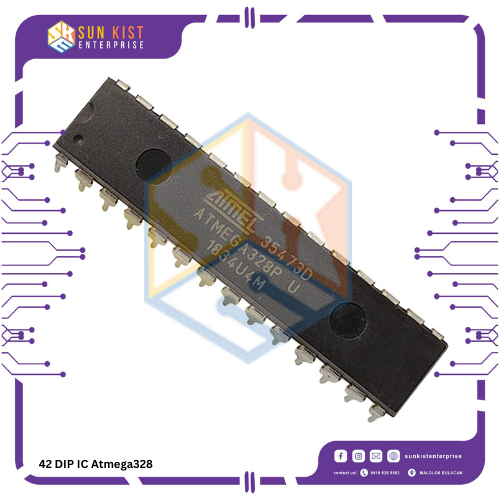Description
The ATmega328 is a microcontroller chip from the Atmel (now part of Microchip Technology) AVR family, and it’s commonly used in various embedded systems and microcontroller projects. The “DIP” in “DIP IC” stands for Dual Inline Package, which is a type of chip package. Here is a description of the ATmega328 DIP IC:
**1. Microcontroller Architecture:** The ATmega328 is based on the AVR RISC (Reduced Instruction Set Computer) architecture. It is an 8-bit microcontroller with a Harvard architecture, which means it has separate program memory (Flash) and data memory (SRAM).
**2. Flash Memory:** The ATmega328 typically has 32KB of Flash memory for storing your program (firmware) code. This memory is non-volatile, which means the code remains stored even when the power is turned off.
**3. SRAM:** It has 2KB of SRAM (Static Random-Access Memory), which is used for temporary data storage during program execution.
**4. EEPROM:** The chip also features 1KB of EEPROM (Electrically Erasable Programmable Read-Only Memory) for non-volatile data storage, where you can store configuration settings or small amounts of data.
**5. Clock Speed:** The ATmega328 can operate at various clock speeds, typically ranging from 1 MHz to 20 MHz, depending on the external crystal or oscillator connected to it.
**6. I/O Pins:** It has 23 general-purpose I/O (GPIO) pins that can be used for digital input/output and some of them can be used for analog input as well. These pins can be used for interfacing with sensors, actuators, and other external devices.
**7. Analog-to-Digital Converter (ADC):** The ATmega328 has a 10-bit ADC, allowing you to read analog signals and convert them into digital values for processing.
**8. Communication Interfaces:** It supports serial communication via UART (Universal Asynchronous Receiver-Transmitter), SPI (Serial Peripheral Interface), and I2C (Inter-Integrated Circuit) protocols, making it suitable for interfacing with various other devices.
**9. Timers and PWM:** The chip includes timers and PWM (Pulse Width Modulation) functionality, which can be used for generating precise timing, controlling servos, or generating analog-like output signals.
**10. Voltage Regulator:** Some ATmega328 chips have an internal voltage regulator, which allows you to power the chip with a wider range of voltages (typically from 1.8V to 5.5V).
**11. In-Circuit Programming:** The ATmega328 can be programmed in-circuit through its ICSP (In-Circuit Serial Programming) header using a suitable programmer, like the AVRISP or Arduino as ISP.
The ATmega328 is a versatile microcontroller widely used in the maker and electronics communities, and it’s the core microcontroller of the Arduino Uno board. It’s suitable for a wide range of applications, from simple LED blinking projects to more complex embedded systems.






Reviews
There are no reviews yet.